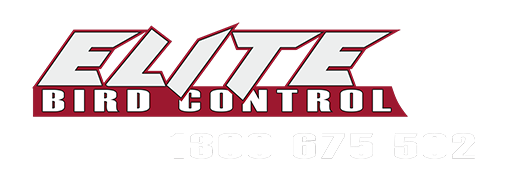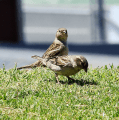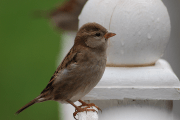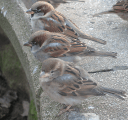Sparrow (passer domesticus)
Sparrow Control & Products
Effective control strategies for Sparrows as follows:
Anti-Bird Netting:– The most effective product for the 100% Exclusion of feral sparrows in all situations. QUALITY “INVISIBLE” SOLUTIONS HDPE Bird Netting is a versatile barrier that denies birds the ability to access literally any architectural configuration and is typically used in applications where maintaining building aesthetics is critical.
The Bird Netting is made from High Density Polyethylene; Polyethylene is the most ultra- violet (U.V) resistant netting material available and has extra U.V. stabilizers added in its raw materials and will not rot or absorb water.
Specific flame-proof netting is also available which contains fire retardant properties that have fine filaments that melt and drop away before propagating a flame. So when the netting is exposed to an open flame the netting literally disappears.
Where required the installation of Heavy Duty Nylon Zippers will be installed to provide access to services incl. Lights, sprinkler valves, smoke detectors, etc.
At ELITE Bird Control we insist on only using quality materials and fixings and we can create innovative designs that are virtually invisible. It is a humane bird control system and will permanently solve your bird infestation problems.
Bird Shock Track:– This system is ideal in most situations because the system provides an intermittent shock that simply teaches the Sparrows to stay away, long term. The electric bird deterrent system is changing the face of the bird control industry – building owners are actually paying to have spikes replaced with this electric deterrent system. The Shock-Track is a low-profiled electrical deterrent system which is flexible and adaptable and can conform to any architectural configuration. Once installed the track is very hard to see close up and virtually invisible from a distance.
Mist Netting/Live Bird Capture:– This innovative strategy can be implemented to catch feral Sparrows. It can be used inside any food manufacturing, preparation, warehousing environments, shopping centers and anywhere the use of poisons (Avicides) is not an option.
Trapping – This method in certain situations can be very effective where there is a heavy Sparrow infestation.
Bird Control Agents:– Only to be carried out by licensed technicians and is limited to be carried out in precise situations and environments for feral Sparrows control.
Bristle Strips and Anti-Bird Mesh Systems:– A proofing solution to exclude Sparrows from seeking out their favorite harbourages where it is not practicable to install other deterrent products.
The House / English Sparrow,
The English Sparrow well established in rural and urban settings, has a both rural and urban impact. They are aggressive and compete with native birds for nesting sites and food. They are quite clever and well known to enter buildings by flying up to door sensors to open doors to then gain access to their regular feeding site. By doing this they often contaminate food products or other merchandises, creating mess and may assist in the spread of diseases such as salmonella and tuberculosis.
IDENTIFICATION:- Approximately 15 centimeters long. Colour varies with the gender. Males have a black patch under the beak, on the cheeks and on the rump. In the winter, the grey feather tips hide these black areas. The top of the male Sparrow’s head is grey-white. Females and young Sparrows are dull brown, with a dirty white breast and brow.
BIOLOGY & BREEDING:- Sparrows prefer to nest in protected man-made and natural areas. Both male and female sparrows construct a large and flimsy nest from straw, grass, feathers, strips of paper, string and other debris. The eggs are white, bluish-white or greenish-white, spotted with brown or grey and clutches usually contain 4 or 5 eggs. The following are popular sparrow nesting and roosting sites:
- In trees and bushes
- Building ledges
- Openings in structures
- Gutters
- Signs
- Light fixtures
- Beneath the eaves of a house
HABITS & DAMAGE:- Sparrows cause considerable damage, as they foul structures with their droppings, particularly those areas used for roosting and loafing sites. Sparrows also create problems by entering food plants, warehouses, department stores and malls where they are scouting for an opportunity to find a quick and easy feed as individuals need to consume as much as 6 grams per day.




